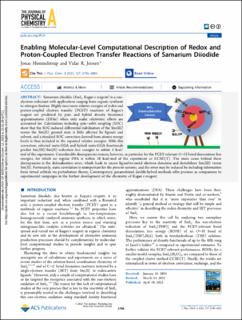Enabling Molecular-Level Computational Description of Redox and Proton-Coupled Electron Transfer Reactions of Samarium Diiodide
Journal article, Peer reviewed
Published version

Åpne
Permanent lenke
https://hdl.handle.net/11250/3108652Utgivelsesdato
2023Metadata
Vis full innførselSamlinger
- Department of Chemistry [433]
- Registrations from Cristin [9766]
Sammendrag
Samarium diiodide (SmI2, Kagan’s reagent) is a one-electron reductant with applications ranging from organic synthesis to nitrogen fixation. Highly inaccurate relative energies of redox and proton-coupled electron transfer (PCET) reactions of Kagan’s reagent are predicted by pure and hybrid density functional approximations (DFAs) when only scalar relativistic effects are accounted for. Calculations including spin–orbit coupling (SOC) show that the SOC-induced differential stabilization of the Sm(III) versus the Sm(II) ground state is little affected by ligands and solvent, and a standard SOC correction derived from atomic energy levels is thus included in the reported relative energies. With this correction, selected meta-GGA and hybrid meta-GGA functionals predict Sm(III)/Sm(II) reduction free energies to within 5 kcal/mol of the experiment. Considerable discrepancies remain, however, in particular for the PCET-relevant O–H bond dissociation free energies, for which no regular DFA is within 10 kcal/mol of the experiment or CCSD(T). The main cause behind these discrepancies is the delocalization error, which leads to excess ligand-to-metal electron donation and destabilizes Sm(III) versus Sm(II). Fortunately, static correlation is unimportant for the present systems, and the error may be reduced by including information from virtual orbitals via perturbation theory. Contemporary, parametrized double-hybrid methods offer promise as companions to experimental campaigns in the further development of the chemistry of Kagan’s reagent.
